Schwerkraftfilter vs. Umkehrosmose:
Welcher passt zu Ihnen?

Der Zugang zu sauberem Wasser ist entscheidend, um die Gesundheit zu erhalten und wasserbedingte Krankheiten zu vermeiden. Da die Bedenken hinsichtlich der Qualität von Leitungswasser zunehmen, greifen immer mehr Menschen zu Wasserfiltersystemen, um sicherzustellen, dass ihr Trinkwasser sicher ist. Probleme wie der Geschmack, der Geruch und das Vorhandensein von Chemikalien im Leitungswasser haben dazu geführt, dass viele gefiltertes Wasser bevorzugen – nicht nur wegen des verbesserten Geschmacks, sondern auch wegen des beruhigenden Gefühls, dass das Wasser sicher ist.
Während Schwerkraftfilter den Geschmack effektiv verbessern und kleinere Verunreinigungen reduzieren, bieten Umkehrosmose-Systeme eine umfassendere Lösung und entfernen eine breitere Palette an Schadstoffen. Überprüfen Sie die Vorteile beider Methoden und entscheiden Sie, welche Lösung am besten zu Ihren Bedürfnissen passt.
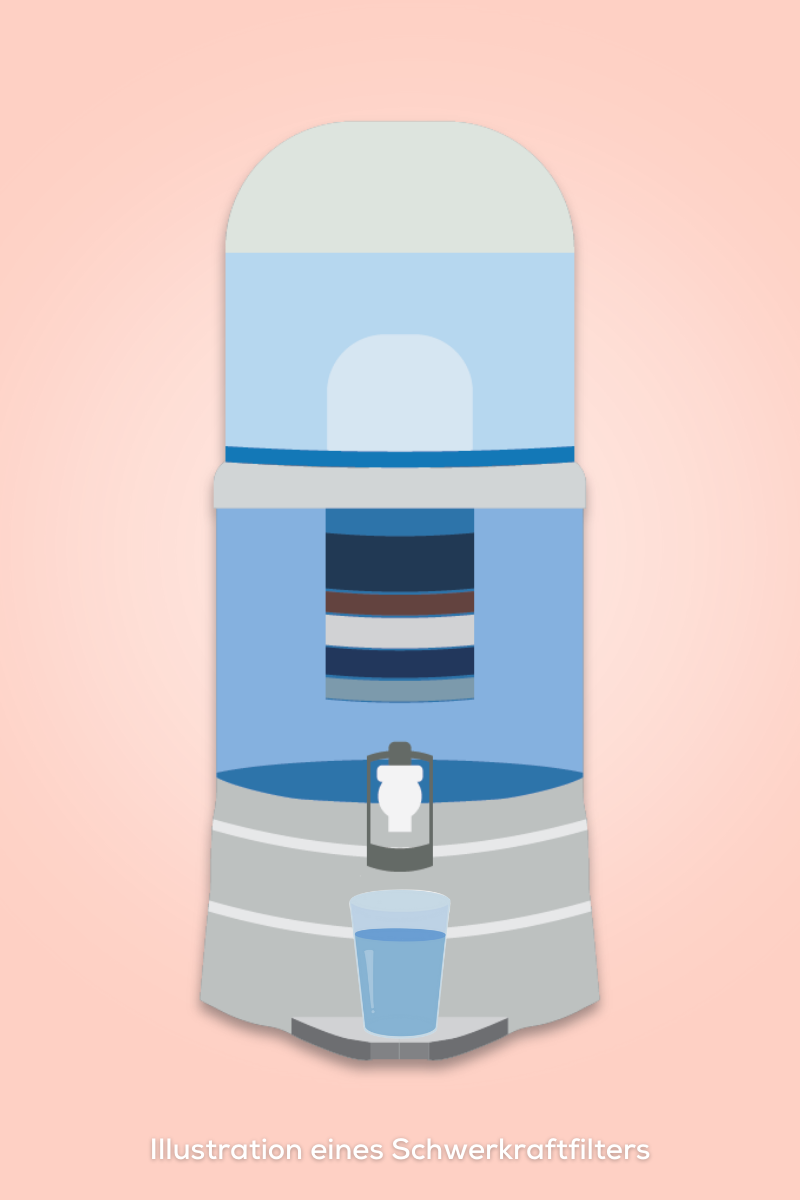
Wie Schwerkraftfilter funktionieren
Schwerkraftfilter vereinfachen den Filtrationsprozess, indem sie die natürliche Anziehungskraft der Schwerkraft nutzen, um Verunreinigungen zu entfernen:
Schritt 1: Wasser einfüllen
Ungefiltertes Wasser wird in die obere Kammer des Schwerkraftfilters gegossen.
Schritt 2: Schwerkraftbasierte Filtration
Die Schwerkraft zieht das Wasser durch ein Filterelement mit mikroskopisch kleinen Poren. Dieses Element verhindert, dass Verunreinigungen und Schadstoffe hindurchgelangen, sodass nur sauberes Wasser in die untere Kammer fließt.
Schritt 3: Schichtweise Filtration
Das Wasser durchläuft verschiedene Schichten von Filtermedien, die oft schichtweise angeordnet sind: mit groberen, größeren Partikeln oben und feineren, kleineren Partikeln unten. Dies hilft dem Filter, eine breite Palette von Verunreinigungen aufzufangen.
Schritt 4: Sammlung des gefilterten Wassers
Das gefilterte Wasser sammelt sich in der unteren Kammer und ist gebrauchsfertig.
Schwerkraftfilter sind benutzerfreundlich und effektiv für die grundlegende Wasserreinigung, erfassen jedoch möglicherweise nicht alle Verunreinigungen.

Wie die fortschrittliche RO-Filtration von AquaTru funktioniert
Die Umkehrosmose-Systeme von AquaTru bieten eine gründlichere Reinigung als Schwerkraftfilter und nutzen eine patentierte 4-Stufen-Technologie, die andere RO-Systeme übertrifft. Im Gegensatz zu anderen Systemen, die verschiedene Filterkombinationen verwenden, ist das einzigartige Setup von AquaTru speziell darauf ausgelegt, die Entfernung von Schadstoffen zu maximieren und gleichzeitig die einfache Nutzung zu Hause zu gewährleisten.
Filtrationsstufen des AquaTru-Systems:
- Sedimentfilter: Der Prozess beginnt mit dem Auffangen größerer Partikel wie Schmutz und Schlamm.
- Aktivkohlefilter: Diese Stufe entfernt Chlor und andere Chemikalien, verbessert den Geschmack des Wassers und verlängert die Lebensdauer der RO-Membran.
- Umkehrosmose-Membran: entfernt nahezu alle Verunreinigungen, einschließlich Schwermetalle, Mikroplastik und Arzneimittel, für makelloses Wasser.
- VOC-Polierfilter: Dieser Filter verfeinert den Geschmack des Wassers und liefert durchgehend frisches und sauberes Wasser.
-
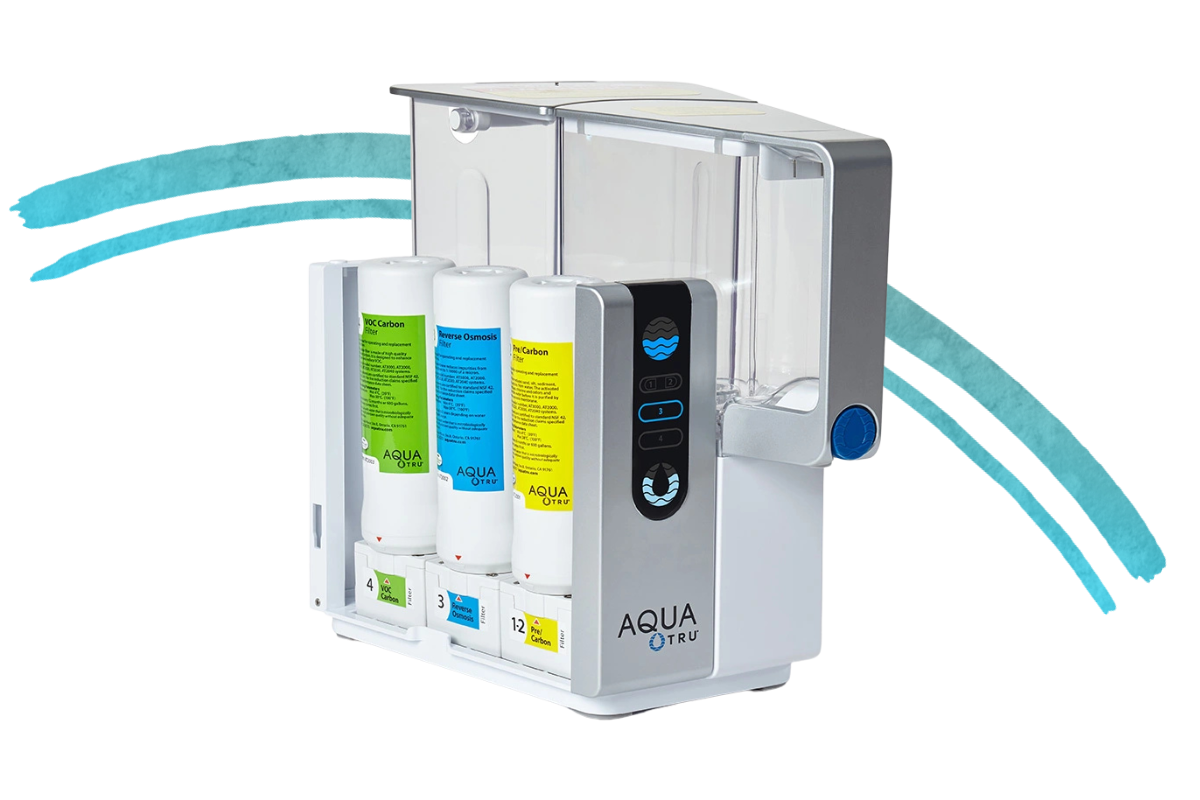
-
Hauptvorteile der RO-Filter von AquaTru:
- Hocheffektiv: entfernt bis zu 99 % der schädlichen Stoffe, einschließlich Schwermetalle, Pestizide, Arzneimittel und sogar Mikroplastik.
- Verbesserter Geschmack und Geruch: Das mehrschichtige Filtersystem sorgt für einen frischen und klaren Wassergeschmack.
- Langlebiges Filtersystem: Aus hochwertigen Komponenten gefertigt, erfordert AquaTru weniger Filterwechsel und weniger Wartung als andere Systeme.
- Ideal für den Hausgebrauch: Die perfekte Lösung für Familien, die ein umfassendes All-in-One-System suchen, um sicheres Trinkwasser zu gewährleisten.
Der fortschrittliche, mehrstufige Prozess von AquaTru entfernt bis zu 99 % schädlicher Verunreinigungen und stellt sicher, dass Sie Wasser von höchster Qualität für den täglichen Gebrauch erhalten. Diese Effizienz wurde unabhängig getestet und wissenschaftlich validiert.
Wichtige Überlegungen: Kosten, ökologischer Fußabdruck und Benutzerfreundlichkeit
Bei der Auswahl eines Wasserfiltersystems ist es wichtig, neben der Filtrationseffizienz auch Faktoren wie Kosten, Umweltauswirkungen und Benutzerfreundlichkeit zu berücksichtigen. Nachfolgend finden Sie einen Vergleich zwischen Schwerkraftfiltern und Umkehrosmose-Systemen wie AquaTru, der diese wichtigen Aspekte hervorhebt und Ihnen bei Ihrer Entscheidung hilft.
Filtrationseffizienz
-
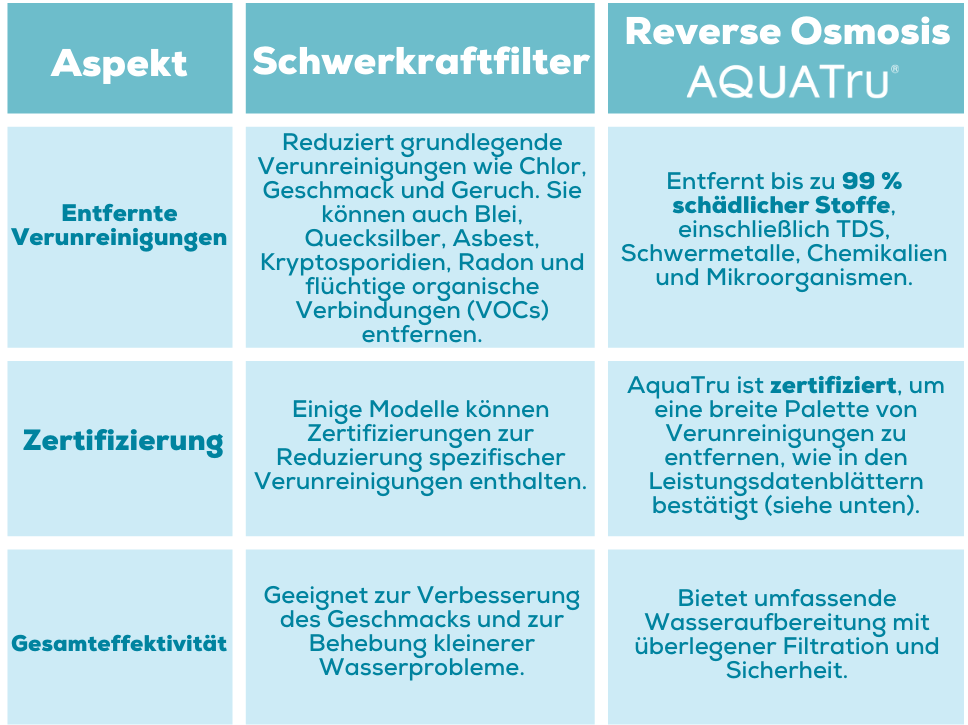
-
Schwerkraftfilter bieten eine grundlegende Filtration, indem sie Chlor reduzieren und den Geschmack sowie den Geruch des Wassers verbessern, sind jedoch weniger wirksam gegen schädlichere Verunreinigungen. Die Umkehrosmose-Technologie von AquaTru entfernt bis zu 99 % der schädlichen Substanzen und bietet eine weitaus effektivere Lösung, um sicherzustellen, dass Ihr Wasser sicher, sauber und rein ist.
Kosten und langfristige Investition
-
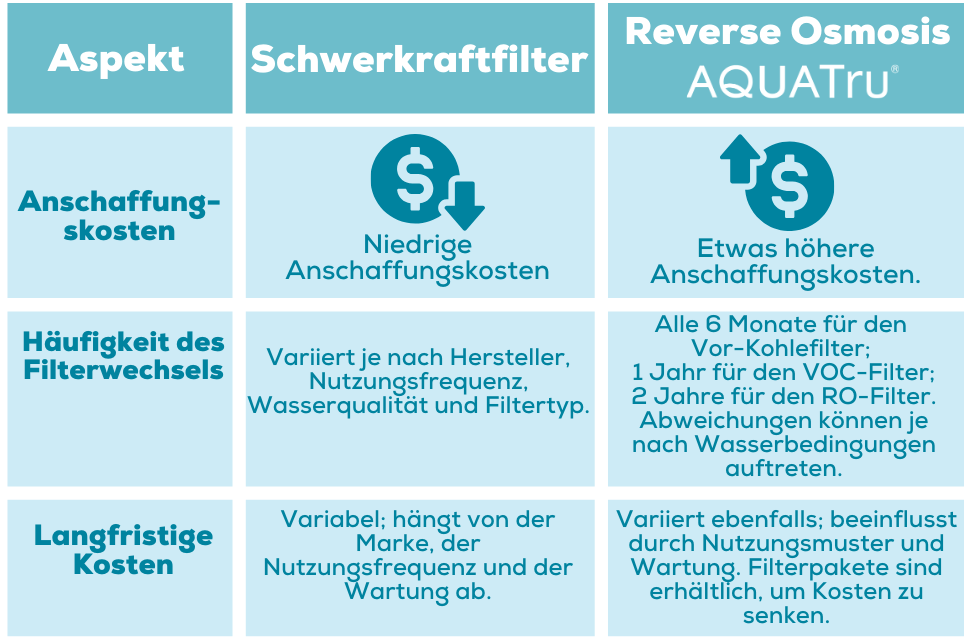
-
Schwerkraftfilter sind anfangs günstiger, aber die langfristigen Kosten können je nach Filterlebensdauer, Nutzungsfrequenz und Wasserqualität variieren. Im Gegensatz dazu haben Umkehrosmose-Systeme von AquaTru einen höheren Anschaffungspreis, können jedoch langfristig Einsparungen bringen, da sie durch verfügbare Filterpakete, effektive Leistung und Langlebigkeit überzeugen, wenn sie ordnungsgemäß verwendet und gewartet werden.
Umweltauswirkungen
-
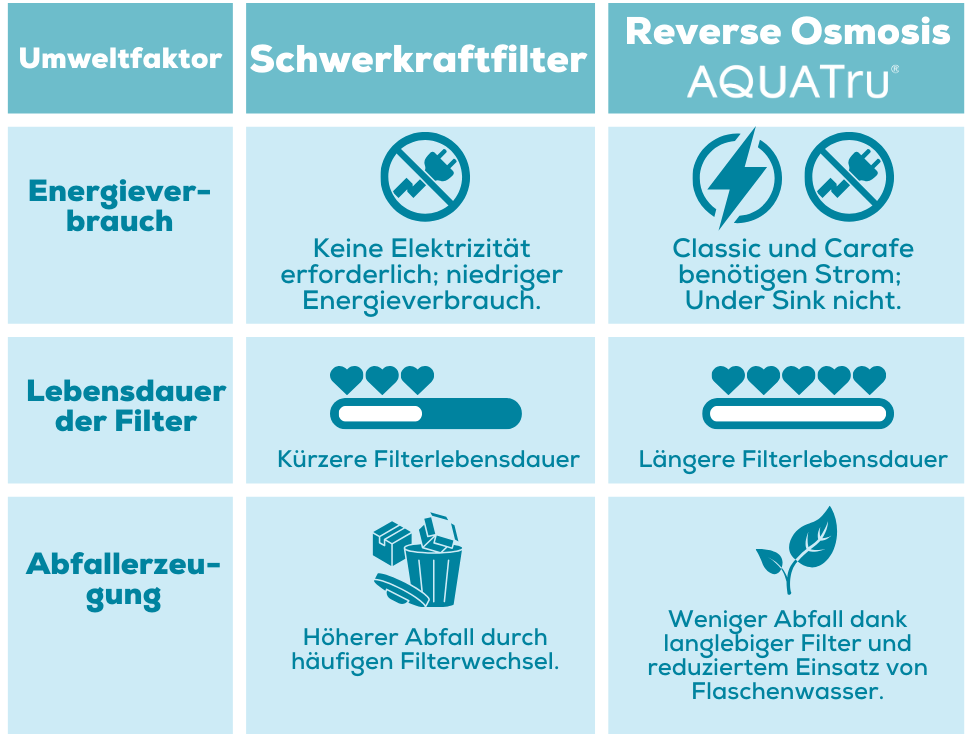
-
Schwerkraftfilter sind energieeffizient, tragen jedoch aufgrund ihrer kürzeren Filterlebensdauer stärker zur Abfallmenge bei. AquaTru-RO-Systeme benötigen zwar Strom, erzeugen jedoch langfristig weniger Abfall und tragen dazu bei, den Plastikmüll durch Flaschenwasser zu reduzieren.
Benutzererfahrung und Komfort
-
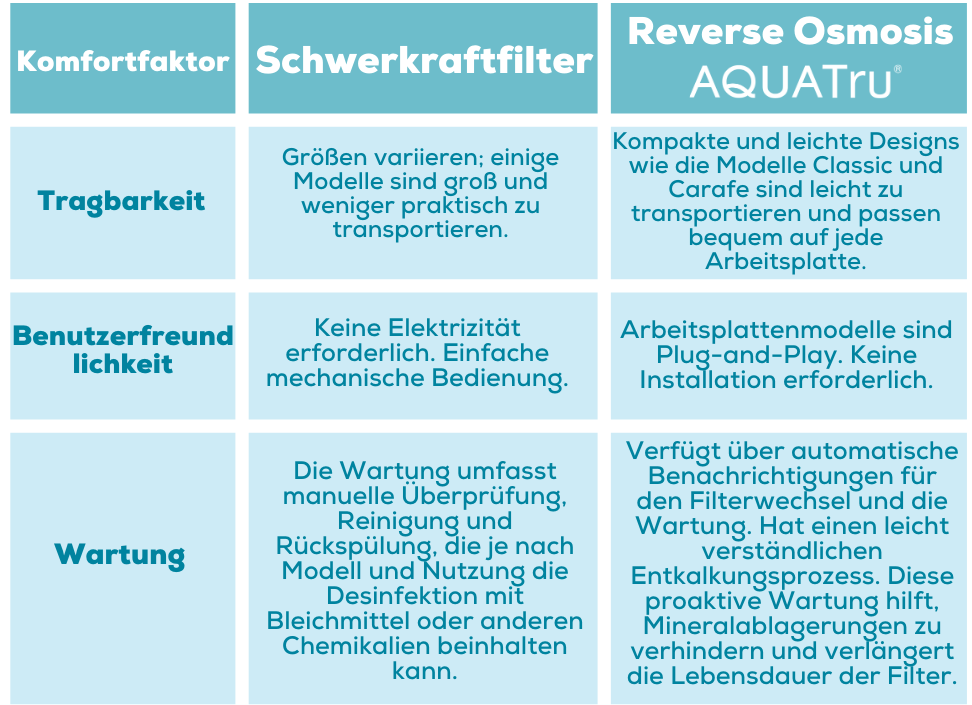
-
Schwerkraftfilter sind zwar einfach einzurichten und funktionieren ohne Strom, sind aber in verschiedenen Größen erhältlich – größere Modelle sind weniger tragbar und erfordern manuelle Wartung wie Reinigung und Rückspülung, manchmal mit chemischer Desinfektion. Im Gegensatz dazu bieten AquaTru-Umkehrosmose-Systeme, insbesondere die Arbeitsplattenmodelle, einen höheren Komfort. Sie sind Plug-and-Play, erfordern keine Installation und lassen sich leicht bewegen, sodass sie sich perfekt auf jeder Arbeitsfläche einfügen. Diese Systeme vereinfachen die Nutzung mit automatischer Filterüberwachung, Wartungswarnungen und einem unkomplizierten Entkalkungsprozess, was sie zu einer idealen Wahl für den regelmäßigen Haushaltsgebrauch mit weniger Wartung macht.
Die Entscheidung zwischen Schwerkraftfiltern und Umkehrosmose-Systemen wie AquaTru erfordert die Abwägung verschiedener Faktoren, einschließlich spezifischer Filtrationsanforderungen, Budget und des gewünschten Grades der Schadstoffentfernung. Während RO-Systeme höhere Anschaffungskosten haben, machen ihre langfristigen Vorteile—weniger Wartung und verbesserte Wasserqualität—sie zu einer attraktiven Option für eine umfassende Wasseraufbereitung. Was AquaTru auszeichnet, ist seine unabhängige Zertifizierung durch IAPMO, getestet nach den NSF/ANSI-Standards 42, 53, 58 und 401. AquaTru entfernt bis zu 99 % schädlicher Stoffe und sorgt für eine sichere, zuverlässige Filtration mit Leistungsdaten zur Überprüfung.
Für weitere Informationen über AquaTru und seine Vorteile besuchen Sie unsere Seite „Why AQT“. Entdecken Sie, wie AquaTru Ihnen helfen kann, eine überlegene Wasserqualität in Ihrem Zuhause zu erreichen. Werfen Sie einen Blick auf unsere Leistungsdatenblätter für die Modelle Carafe und Classic, um zu sehen, wie effektiv die AquaTru-Filtergeräte Verunreinigungen entfernen.









